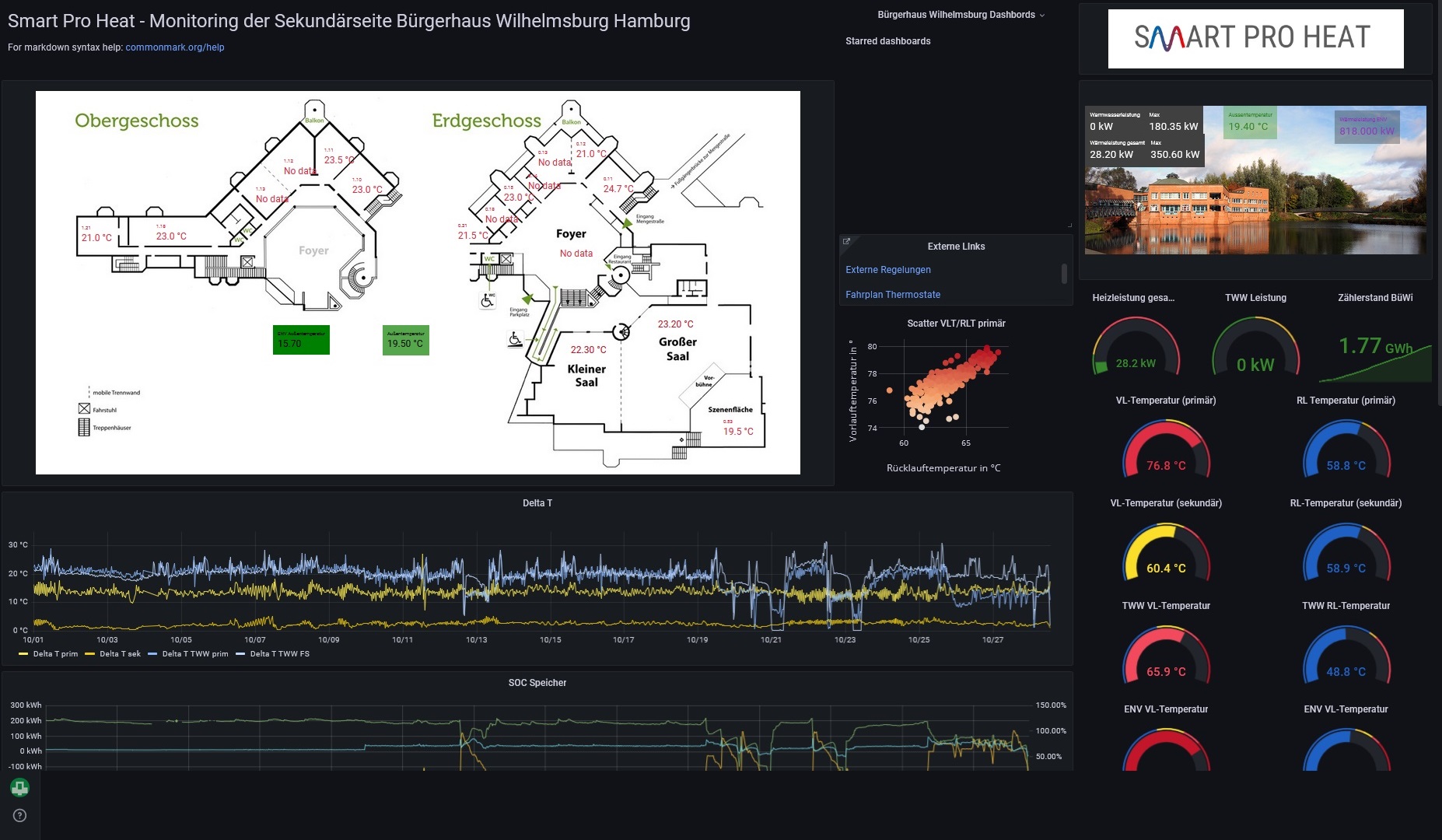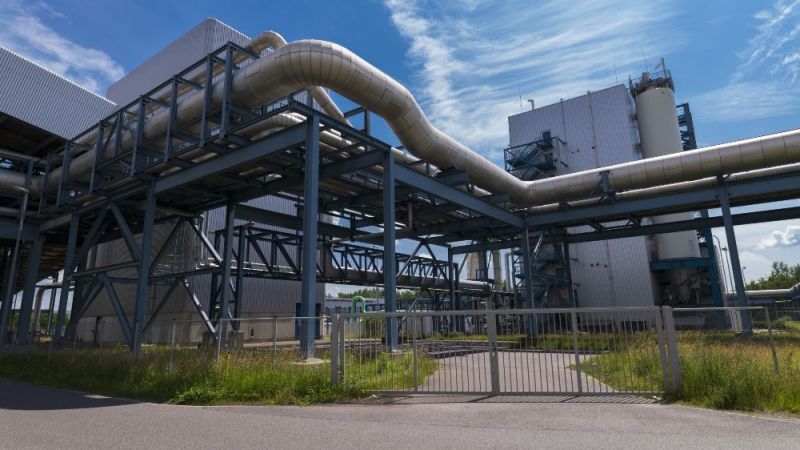
More Flexible and Efficient
Combining Building Control Systems and Heating Networks Through Smart Networking
From automatic building control systems to smart thermostats in private homes, more and more buildings are using smart technology for their heating needs. These kinds of systems make heating cheaper and more efficient and enable renewable heat generated by consumer facilities to be better integrated into the domestic supply network. Smart technology can also be used on a much larger scale, to control entire heating networks. Standard control technology makes basic adjustments to the heat supply according to weather conditions and the time of day. Integrating system control in the electricity sector, either through combined heat and power or power-to-heat systems, for example, is somewhat more complex. The missing link here is an interface that sits between the building network and the heating network.
Integrating building control into the heating network
As part of the SmartProHeaT (Smart Prosumer Heating Technologies) project, researchers explored ways to increase the energy flexibility of buildings from a design and technology perspective. Insights gained as part of this project will now be used to enhance heating supply efficiency in the long term. The perspective of this approach is particularly innovative, since buildings are usually viewed as passive components within the heating network. In this case, however, the SmartProHeaT team is investigating what effect flexible buildings might have on the heating network.
To increase the energy flexibility of buildings and integrate them into a heating network, the SmartProHeaT research team developed and tested a number of different concepts. They also collaborated with the Smart Heat Grid Hamburg project team, who have established an intelligent heating network in the city’s Wilhelmsburg district. Similarly to SmartProHeaT, the project was supported by the Hamburg University of Applied Sciences. The Wilhelmsburg community centre in Hamburg was used as a prototype building.
An interface for enhanced efficiency
When efficiency measures are not adapted to work with each other, it can be detrimental to their impact. For instance, if a combined heat and power unit is installed in a building alongside a connection to the heating network, this will have an impact on the heating network. In this case, the house uses its own system to meet its base load and only uses the heating network during peak demand. However, without an interface, this information cannot reach the network operator and supply cannot be adjusted to the new conditions. This has an adverse impact on the heating network; for example, input temperatures may be too high and therefore inefficient.
As part of the European Strategic Energy Technology (SET) plan, the researchers also collaborated with Aalto University in Finland. Working together, they conducted various simulations incorporating demand-response measures (DR), i.e. measures designed to enable the flexible, demand-driven control of buildings within a heating network.
Im Forschungsprojekt Smart Heat Grid Hamburg wird ein intelligentes Wärmenetz entwickelt und testweise in einem Nahwärmenetz in Hamburg-Wilhelmsburg umgesetzt. Ähnlich wie ein Smart Grid im Stromsektor kann ein intelligentes Wärmenetz (Smart Heat Grid) flexibel an veränderte Bedingungen angepasst werden. So wird die Netzkapazität bestmöglich ausgenutzt. Das Projekt baut auf dem Vorgängervorhaben „Smart Power Hamburg“ auf, das untersucht hat, wie der Anteil erneuerbarer Energien an der Strom- und Wärmeversorgung durch den Einsatz intelligenter Wärmstruktur erhöht werden kann.
Flexibility saves energy and lowers costs for both producers and consumers
The scientists began by creating simulations where various building types with different control approaches were integrated into an intelligent heating network. They used the examples of an apartment building, a cultural centre, and an office building. To ensure optimum alignment of demand-response measures to current supply and demand, the researchers developed an hourly heating price for end users. A similar model is already in use in the electricity sector, with smart meter tariffs, for example. These models are not yet widely used in Germany.

In their simulations, the main focus of the SmartProHeaT team was on the producer side. However, apart from analysing the impact of demand-response measures on consumers, they also looked at the heating network as a whole. The simulations created with the Finnish researchers indicated that the measures had a positive effect in all observed scenarios. Flexibility increased as a result of intelligent demand-response control across all building types, and equated to between 3 and 26 % for charging, and minus six to minus 31 % for discharging. In turn, this flexibility enabled improved control of generation systems, leading to a reduction in energy costs. The simulations showed that demand-response measures can achieve energy savings of between 0.5 and 7.7 %, and cost savings of between 0.7 and 8.1 %. Heat producers and consumers alike stand to benefit.
What makes a building energy flexible?
The energy flexibility of a building relates to its capacity to adapt its energy demand and supply to external conditions. This can be local climate conditions, or demand from the network or from other users. Increased energy flexibility in both the heating and electricity sector facilitates load transfer and avoids peak loads. One way to determine the energy flexibility of a building is to calculate the length of time that energy use can be delayed, for example; in other words, the length of time between the point at which the energy is generated or supplied and the point at which it is used. In terms of heating supply, energy flexibility also refers to how well a building can deviate from its standard load profile. A building is particularly flexible when it can respond to external circumstances without any loss in comfort for its occupants.
The SmartProHeaT team put this concept to the test at the Wilhelmsburg community centre in Hamburg. They installed a total control-loop system in the test building to allow bidirectional communication. A replica of the heating network operator’s control room was set up at the Hamburg University of Applied Sciences (HAW Hamburg) where it received real-time measurement data from the building via an interface, while also controlling the building remotely. At the time, there were no standard products available for ensuring this bidirectional control. The corresponding gateways were therefore developed as part of the project and may well form the basis for a new standard.
Identifying and achieving savings potential in real time
The researchers also experimented with temperature flexibility. A heating circuit control system detects the minimum inlet temperature required by the community centre and transmits this directly to the network operator via the newly developed communication interface. The researchers established that the test building can be operated with a ten-degree reduction in inlet temperature. This allowed a reduction in safety requirements, which saves on energy, and cost. Measurement technology can analyse the heating supply in the building right down to the level of individual radiators. With this information, the researchers were able to establish that by replacing individual radiators in a small number of rooms – selective renovation – there was potential to reduce the required inlet temperature even further.
Integrating interfaces in smart products
The project demonstrates that by integrating buildings into the heating network and enhancing building energy flexibility, energy demand can be reduced for the overall system. However, the researchers also concluded that the investment costs required to integrate all building stock within the catchment area into a heating network are still excessive. There is a need for plug-and-play solutions for smart technology within the heating sector. In the long term, these systems could be integrated into existing smart home devices and used free of charge. The researchers also propose that temperature flexibility and safety requirements be investigated.

Additional links
Paper within the scope of the project:
Analyzing energy flexibility by demand response in a Finnish district heated apartment building
Demand Response Control of Space Heating in Three Different Building Types in Finland and Germany
Design of a Smart Thermal Grid in the Wilhelmsburg district of Hamburg: Challenges and approaches





















